Inbox and Environment News - Issue 249
January 30 - February 6, 2016: Issue 249
Fauna Passes on Mona Vale Road: Update
January 27, 2016 - Pittwater Natural Heritage Association (PNHA)
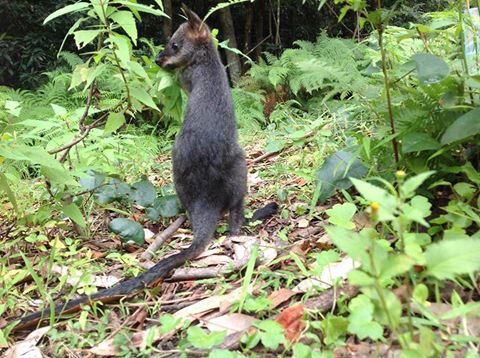
Will the young Swamp Wallaby be able to cross Mona Vale Road?
Update on the RMS proposal to upgrade and widen a 3.2km section of Mona Vale Road East between Ingleside and Mona Vale:
Thanks to those PNHA members who made a submission in response to the Review of Environmental Factors (REF) which was displayed in July and August 2015. Our voices do make a difference.
156 submissions were made, many commenting on issues related to biodiversity and water quality. The PNHA submission focused on fauna connectivity, making the point that we need more fauna crossings on Mona Vale Road east than the one proposed by RMS and that these crossings must be located so that they align with dedicated fauna corridors through the Ingleside precinct.
Although the RMS did not fully address our concerns, they have agreed that in addition to the one fauna underpass planned for the vicinity of Narrabeen Creek, they will investigate the upgrade of existing pipe culverts near Ingleside Road to create more fauna underpasses.
The agreement by RMS to investigate more locations for fauna underpasses indicates that we have made some headway. However it is still not good enough and we will continue campaigning for survival of our native wildlife in Katandra and Ingleside Chase Reserve. Our next step is to meet with Planning Minister Rob Stokes and senior staff from Department of Planning and Environment.
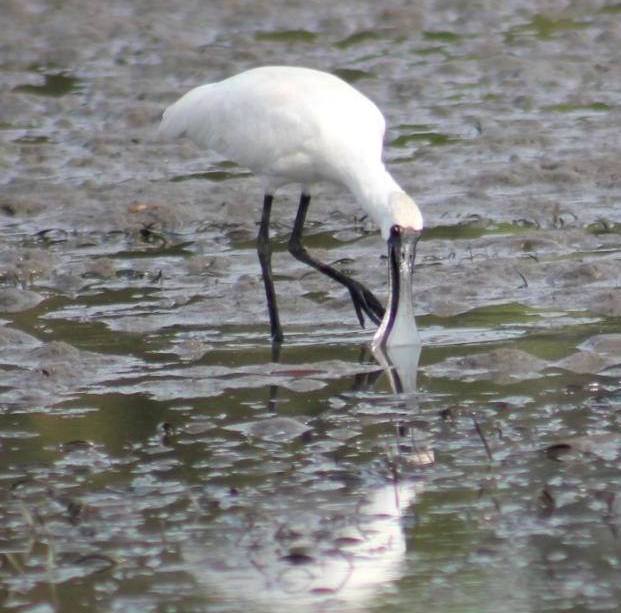
WORLD WETLANDS DAY 2016
Make a Minute To Appreciate our PITTWATER WETLANDS This coming Tuesday - February 2nd.
Wetlands for our Future: Sustainable Livelihoods is the theme for World Wetlands Day in 2016.
This theme is selected to demonstrate the vital role of wetlands for the future of humanity and specifically their relevance towards achieving the new Sustainable Development Goals.
World Wetlands Day is celebrated every year on 2 February. This day marks the date of the adoption of the Convention on Wetlands on 2 February 1971, in the Iranian city of Ramsar on the shores of the Caspian Sea. Since 1997, the Ramsar Secretariat provides outreach materials to help raise public awareness about the importance and value of wetlands. Click here.
MORE THAN A BILLION PEOPLE MAKE A LIVING FROM WETLANDS . . .
Livelihoods from fishing, rice farming, travel, tourism, and water provision all depend on wetlands. And wetlands are vital to us in many other ways. They host a huge variety of life, protect our coastlines, provide natural sponges against river flooding, and store carbon dioxide to regulate climate change.
Unfortunately, wetlands are often viewed as wasteland, and more than 64% of our wetlands have disappeared since 1900.
Enabling people to make a decent living, and at the same time ensuring that wetlands can still provide their essential benefits, do not have to be conflicting goals!
Top - Royal Spoonbill feeding at Careel Bay Mangroves - wetlands - A J Guesdon photo
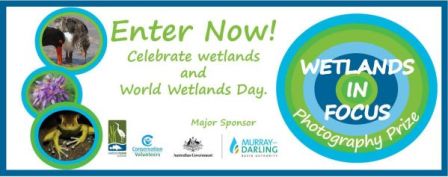
WetlandCare Australia and Conservation Volunteers Australia invite photographers of all ages to enter the Wetlands in Focus photography prize.
Join us in celebrating and sharing Australia’s wonderful wetlands and waterways!
It’s easy and free to enter and get involved – just capture your favorite Australian wetland flora (plant), fauna (animal) or landscape on camera, and submit your shot in the easy to use form on the Wetland Care Australia website.
There’s even a category for photos of wetland volunteers in action, the perfect way to showcase the hard work and dedication of wetland carers around the nation.
All entries will be publicly displayed, with Entrant’s Name, Entry Title, Artists Statement and category entered into, on the WetlandCare Australia Facebook page where you and all your friends can vote for the People’s Choice Prize by liking your fave photo.
Wetlands in Focus is dedicated to spreading the word about Australia’s amazing wetlands and the fantastic people like you who care about them.
Entries are open right up to the end of February 2016, which will be a month of wetland celebrations and events, marking World Wetlands Day.
Entries close February 29 2016, voting for the People's Choice closes March 3 2016.
World Wetlands Day falls on February 2nd each year and commemorates the anniversary of the signing of the Ramsar Convention on Wetlands of International Importance on the 2nd February 1971.
The theme for World Wetlands Day 2016 is Wetlands for our Future: Sustainable Livelihoods
There will be wetland themed events happening in locations around Australia during February 2016, watch this space for more details!
For Prize Details and to Enter visit the Wetland Care Australia website.
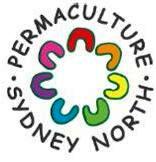 EDIBLE WEEDS TOUR
EDIBLE WEEDS TOUR
Sunday, February 7, 2016: 10:00am – 11:00pm
Naturalist Diego Bonetto will introduce you to the wonders and possibilities of edible weeds on a two hour urban tour on the northern beaches. Building on the knowledge acquired while growing up on a farm in Italy, Diego introduces people to the ever-present food and medicine plants that surround us. To some plantain, dandelion, chickweed and sow-thistle are a nuisance, to others they are a delicious salad and a seasonal treat. Learn about the most common species growing in your garden, along the green belts and in parks and reserves. Find out how they have been used for food, craft and natural remedies and discover ways to safely harvest from the urban 'wild' and enrich your diet with vitamins and minerals.
Please be quick to register as we are set to a maximum of 25 people for our exclusive Permaculture Northern Beaches weed tour.
$25 non-members, $20 members.
Bookings are essential contact: Cathy.natoli@hotmail.com
Geelong Star Trawler Suspended
_______________
Action taken after albatross mortalities
29 January 2016: AFMA
Following a higher than expected level of albatross mortalities on the Geelong Star’s last fishing trip in the Small Pelagic Fishery, the vessel will not fish again until additional mitigation measures are agreed by Australian Fisheries Management Authority (AFMA) to minimise any further interactions.
AFMA’s acting Chief Executive Officer Dr Nick Rayns said that AFMA would continue to work with the operator, Seafish Tasmania, and seabird experts until the Authority was satisfied that the additional measures would be effective.
“Minimising interactions with protected species, including albatross, is a requirement of good fisheries management,” Dr Rayns said.
“AFMA has investigated the likely cause of the albatross mortalities and is working with the vessel operator and seabird experts to minimise any future albatross interactions.
“AFMA must be satisfied with the additional mitigation measures before fishing can recommence.
“An AFMA observer and an electronic monitoring system will continue to monitor the vessel’s fishing operations, providing 24/7 monitoring coverage for the vessel.”
More information about the management of the SPF can be found atafma.gov.au.
Hypercapnia - why intoxicated fish isn’t as funny as it sounds
UNSW TV
High concentrations of CO2 in seawater can cause fish to become intoxicated - a phenomena known as hypercapnia. UNSW’s Ben McNeil and Tristan Sasse explain how a rise in our oceans’ CO2 levels could have huge implications for global fisheries and marine ecosystems.
UNSW researchers have found that carbon dioxide concentrations in seawater could reach levels high enough to make fish “intoxicated” and disoriented many decades earlier than previously thought, with serious implications for the world’s fisheries.
The UNSW study, published in the journal Nature, is the first global analysis of the impact of rising carbon dioxide emissions from fossil fuels on natural variations in carbon dioxide concentrations in the world’s oceans.
“Our results were staggering and have massive implications for global fisheries and marine ecosystems across the planet,” says lead author, Dr Ben McNeil, of the UNSW Climate Change Research Centre. See: www.ccrc.unsw.edu.au
“High concentrations of carbon dioxide cause fish to become intoxicated – a phenomenon known as hypercapnia. Essentially, the fish become lost at sea. The carbon dioxide affects their brains and they lose their sense of direction and ability to find their way home. They don’t even know where their predators are.
“We’ve shown that if atmospheric carbon dioxide pollution continues to rise, fish and other marine creatures in CO2 hotpots in the Southern, Pacific and North Atlantic oceans will experience episodes of hypercapnia by the middle of this century – much sooner than had been predicted, and with more damaging effects than thought.
“By 2100, creatures in up to half the world’s surface oceans are expected to be affected by hypercapnia.”
The study is by Dr McNeil and Dr Tristan Sasse of the UNSW School of Mathematics and Statistics.
Ocean hypercapnia is predicted to occur when atmospheric carbon dioxide concentrations exceed 650 parts per million.
The UNSW scientists utilised a global database of seawater carbon dioxide concentrations collected during the past 30 years as part of a variety of oceanographic programs.
“We then devised a numerical method to work out the natural monthly peaks and troughs in carbon dioxide concentrations during the year across the surface of the world’s oceans, based on these observations,” says Dr Sasse.
“This allowed us to predict for the first time that these natural oscillations will be amplified by up to tenfold in some regions of the ocean by the end of the century, if atmospheric carbon dioxide concentrations continue to rise.”
To help accelerate this important area of research, the UNSW scientists have also offered prizes to other researchers who can improve on their results.
“Predicting the onset of hypercapnia is difficult, due to a lack of global ocean measurements of carbon dioxide concentrations,” says Dr McNeil.
“We are challenging other scientists with innovative predictive approaches to download the dataset we used, employ their own numerical methods and share their final predictions, to see if they can beat our approach.”
The competition and prizes are outlined on the thinkable.org website, of which Dr McNeil is founder.
New Traps have Arrived: Pittwater Indian Myna Action Group
January 28th, 2016
NEWSFLASH!! TRAPS HAVE ARRIVED!!
We have traps available now for would-be trappers in Pittwater to join the Campaign. It's very simple to become a trapper and if you want to do something positive in controlling this introduced species please contact us NOW!!
IF YOU ARE NOT A PITTWATER RESIDENT WE CAN STILL HELP YOU!!
That's right - we have access to traps for all Northern Beaches residents who want to do their bit. Please message us and we will give you details how to acquire your own trap.
We are looking for people to get involved with our trapping program in Pittwater. We now have 18 traps out in Pittwater!! So if you would like to do something positive about ridding our community of this pest bird please contact us. We will also be rolling out our monthly update program to record trapping numbers and generally making sure you are all happy trappers!
Avalon Boomerang Bags 2016 Workshops
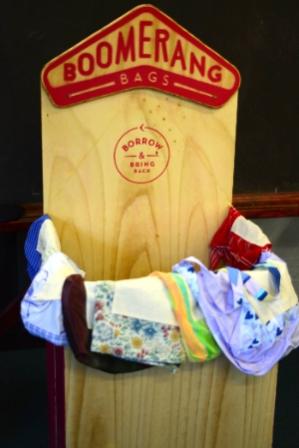 It was great to see some of our regular volunteers yesterday at our first workshop of the year - thanks everyone for showing up and kicking off the year in style. There will be no workshop next Tuesday 26th January due to Australia Day, however, we look forward to seeing you all at the next workshop on Tuesday 2nd February 11:30am- 5pm.
It was great to see some of our regular volunteers yesterday at our first workshop of the year - thanks everyone for showing up and kicking off the year in style. There will be no workshop next Tuesday 26th January due to Australia Day, however, we look forward to seeing you all at the next workshop on Tuesday 2nd February 11:30am- 5pm.
For those of you unable to come to workshops there are many other ways to get involved, just let us know you're willing by leaving a comment or sending us a message.
Pictured is a Boomerang Bag Box as will be provided around Avalon Shopping area full of our Boomerang Bags to "Borrow and Bring Back" Workshops are every Tuesday in Avalon Rec. Centre.
Global nitrogen footprint mapped for first time: 4 Countries Causing 45%
26 January 2016
Four countries cause almost half the world’s emissions, with developing countries tending to suffer local pollution caused by foreign demand
The first-ever global nitrogen footprint modelling has found the United States, China, India and Brazil are responsible for 46 percent of the world's nitrogen emissions. The international collaboration led by the University of Sydney traced the flow of emissions from 188 countries, noted a trend for increased nitrogen production and found wealthy nations largely responsible for pollution abroad caused by local consumption.
Wealthy countries are responsible for more than 10 times the emissions of the poorest nations. PhD candidate Arunima Malik
Net importers and net exporters. Credit: University of Sydney.
The first-ever global nitrogen footprint, encompassing 188 countries, has found the United States, China, India and Brazil are responsible for 46 percent of the world’s nitrogen emissions.
The international collaboration, led by the University of Sydney’s Integrated Sustainability Analysis team, found developing countries tend to embody large amounts of nitrogen emissions from their exports of food, textiles and clothing. Australia is one of the few wealthy nations that is a net exporter of nitrogen, because of the substantial agriculture industry.
The economic modelling, which grouped the nitrogen footprint into top-ranking bilateral trade relationships, noted a trend for increased nitrogen production and found developed nations largely responsible for emissions abroad for their own consumption.
PhD candidate Ms Arunima Malik, who co-authored the paper with University of Sydney colleagues Professor Manfred Lenzen and Dr Arne Geschke, as well as two researchers from Yokohama National University and one from Kyushu University in Japan, said significant nitrogen net importers were almost exclusively developed economies.
“High-income nations are responsible for more than 10 times the emissions of the poorest nations,” Ms Malik said. “This reflects greater consumption of animal products, highly processed foods and energy-intensive goods and services,”
The vast bulk of emissions came from industries such as agriculture, transport and energy generation. Emissions from consumers-end use were mostly from sewage.
A paper on the research is published today by the international journal Nature Geoscience.
Findings of the research of 2010 data includes:
• Consumption in the United States, China, India and Brazil is responsible for 46 percent of global nitrogen emissions.
• Japan and other developed nations import reactive nitrogen embodied in Chinese-made clothing as well as US and Australian meat.
• The United Kingdom, Germany, Italy, and France exchange significant amounts of nitrogen emissions embodied in food products.
• Hong Kong’s nitrogen imports are primary agricultural and raw food products because it lacks land to produce its own livestock and crops.
• Developing countries such as China, India, Pakistan, and Thailand embody large amounts of nitrogen emissions into their exports of textiles and clothing.
• High-income exceptions are Australia, New Zealand, and Argentina, which export significant nitrogen embodied in livestock products.
• Per-capita nitrogen emission ranged from more than 100 kg annually for wealthy nations such as Hong Kong and Luxembourg, to less than 7 kg for developing nations such as Papua New Guinea, Côte d’Ivoire, and Liberia.
• Of the 189 teragrams of nitrogen emitted worldwide in 2010, 161 Tg was emitted from industries and agriculture and only 28 Tg was emitted by consumers.
Substantial nitrogen pollution embedded in international trade.Azusa Oita, Arunima Malik, Keiichiro Kanemoto, Arne Geschke, Shota Nishijima & Manfred Lenzen. Nature Geoscience (2016) doi:10.1038/ngeo2635. Received 27 July 2015. Accepted 14 December 2015 Published online 25 January 2016 Corrected online 28 January 2016
Community feedback sought for the Wilpinjong Extension Project
27.01.2016: Departmental Media Release - Department of Planning and Environment
A proposal to expand the Wilpinjong Coal Mine located approximately 40 kilometres northeast of Mudgee will be on exhibition from today for community feedback.
The Department of Planning and Environment is keen to hear the community’s views on the proposal which seeks to create a new open cut pit to the east of existing operations, extend various existing open cut pits and extend the life of the mine by seven years (to 2033).
The project will be subject to a comprehensive merit assessment process and will include reviews by State government agencies and the Commonwealth Independent Expert Scientific
Committee. The Department of Planning and Environment will also be engaging a number of experts to provide independent advice on the project.
A spokesperson for the Department of Planning and Environment said the local community always has an opportunity to share their views.
“Community consultation is an integral part of the planning process and the applicant will have to respond to the feedback.
Submissions we receive are taken into consideration when we develop our recommendations,” the spokesperson said.
“It’s easy to participate by going online and we encourage everyone to take a look and have their say.”
The Department will hold a community information session in the local area to assist residents in preparing their submissions and understanding the development assessment process.
Further details about the meeting will be provided shortly.
To make a submission or view the EIS, visit www.majorprojects.planning.nsw.gov.au
Submissions can be made from Wednesday, 27 January 2016 until Thursday, 10 March 2016.
Written submissions can also be made to: Department of Planning and Environment, Attn: Executive Director – Resource Assessments and Business Systems, GPO Box 39. Sydney NSW 2001
The application and EIS are also available to view in person at:
• Department of Planning and Environment, 23-33 Bridge Street, Sydney
• Mid-Western Regional Council, 86 Market Street, Mudgee
• Mid-Western Regional Council, 109 Herbert Street, Gulgong
• Nature Conservation Council, Level 2, 5 Wilson Street, Newtown
_________________________
Direct link: http://www.majorprojects.planning.nsw.gov.au6764
Project Summary – retrieved from EIS:
ES3.2 PROJECT SUMMARY The main activities associated with the Project would include: • open cut mining (Plate ES-1) of ROM coal from the Ulan Coal Seam and Moolarben Coal Member in Mining Lease 1573 and in new Mining Lease Application areas in Exploration Licences 6169 and 7091; • open cut extensions (Figure ES-3), including: - approximately 500 hectares of incremental extensions to the existing open cut pits in areas of Mining Lease 1573 and Exploration Licence 6169; and - development of a new open cut pit of approximately 300 hectares in Exploration Licence 7091 (Pit 8); • continued production of up to 16 Mtpa of ROM coal; • extension of the approved mine life by approximately seven years (i.e. from approximately 2026 to 2033); • a peak operational workforce of approximately 625 people; • continued use of the approved Wilpinjong Coal Mine CHPP and general coal handling and rail loading facilities and other existing and approved supporting mine infrastructure; • rail transport of approximately 13 Mtpa of thermal product coal to domestic and export customers (within existing maximum and annual average daily rail limits); • relocation of a section of the TransGrid Wollar to Wellington 330 kilovolt electricity transmission line to facilitate mining in Pit 8; • various local infrastructure relocations to facilitate the mining extensions (e.g. realignment of Ulan-Wollar Road and associated rail level crossing, relocation of local electricity transmission lines and services); • construction and operation of additional mine access roads to service new mining facilities located in Pits 5 and 8; • construction and operation of new ancillary infrastructure in support of mining including mine infrastructure areas, ROM pads, haul roads, electricity supply, communications installations, light vehicle roads, access tracks, remote crib huts, up-catchment diversions, dams, pipelines and other water management structures; • ongoing exploration activities; and • other associated minor infrastructure, plant and activities.

Pittwater Council Environment Events and Workshops February 2016
Detox your home!
13th Feb 2016: 10am - 11:30am
Save money and reduce the number of chemicals in your home
Get inspired to clean your home without the nasty chemicals. With a range of different options this workshop will give you advice on how to choose the right products and how to make your own green cleaners. Get expert advice on how to keep your home clean and green.
Where: Coastal Environment Centre, Lake Park Road, North Narrabeen.
Bookings Essential! • Online • In person: Coastal Environment Centre, Lake Park Road, North Narrabeen • Phone: 1300 000 232 (Reception - Option 1)
Native Bee Workshop
7th Feb 2016
Two session times are available.
Do you want to learn more about native bees? Pittwater Council will be holding workshops on native bees and how to keep them. Native bees are a fantastic part of our environment and are very seldom seen.
Learn about how these communities of native bees live, breed and forage for food. Find out how and what you need to do, grow and avoid in your garden to ensure a healthy hive. Can you tell the difference between a fruit fly and a Stingless Bee?
Tim Heard, native bee expert will be presenting his very popular workshop on keeping native bees. You will learn how to identify and keep native bees as well as how to extract honey from the hives.
Cost: $20. This cost will include a copy of Tim Heard's latest publication.
Where: Coastal Environment Centre, Lake Park Road, North Narrabeen.
The following sessions are being conducted:
• Session 1: 9am - 12noon
• Session 2: 1 - 4pm
Bookings Essential! • Online • In person: Coastal Environment Centre, Lake Park Road, North Narrabeen • Phone: 1300 000 232 (Reception - Option 1)
Birding Morning
14th Feb 2016: 7am - 9am
Come for a morning with the birds.
We will take you for a fantastic guided walk to learn more about our feathered friends. Our birding mornings are guided by local experts and are a great opportunity to get a better look at out local bird life. A great activity for those people interested to learn more as well as passionate birdwatchers.
Where: Deep Creek Reserve. Meet point provided on booking (select Birding Walk).
Bookings Essential! • Online • In person: Coastal Environment Centre, Lake Park Road, North Narrabeen • Phone: 1300 000 232 (Reception - Option 1)
Ingleside Escarpment Walk
21st Feb 2016: 9am - 12pm
A stunning bushland reserve with a beautiful waterfall.
Come and join us for a walk through Ingleside Chase Reserve which is Pittwater's largest continuous piece of bushland. It contains many beautiful plant communities and threatened fauna.
The walk will commence at Irrawong-Epworth Reserve and climb to Ingleside Park. At the park we will have a morning tea break and then head back down. The track is 1.5km one-way and is a little steep in parts so although we will be taking it at a gentle pace a reasonable level of fitness is required.
Where: Irrawong and Ingleside Chase Reserve. Meeting point provided on booking.
Bookings Essential! • Online • In person: Coastal Environment Centre, Lake Park Road, North Narrabeen • Phone: 1300 000 232 (Reception - Option 1)
Seeking community thoughts on planned threatened species work in NSW
Media release: OE&H NSW Govt.
Are you interested in saving the Brush-tailed Rock-wallaby, a small agile marsupial with a distinctive bushy tail? Or the strikingly marked Malleefowl, a ground-dwelling bird known for its loud call? Or the rare and unusual looking Wollemi pine known as the ‘Dinosaur tree’?
Office of Environment and Heritage (OEH) Chief Executive, Terry Bailey today invited the community, ecologists and threatened species experts, to get online and review the latest draft conservation project plans to save 47 (4 iconic, 24 site-managed and 19 landscape-managed species) of the State’s almost 1,000 threatened species.
“Already there are a number of important Saving our Species conservation projects underway across NSW with government and community working together to conduct breeding programs, monitor species and restore habitat areas,” Mr Bailey said.
“This new group of draft conservation strategies, developed in conjunction with species experts are now online and we are looking for community feedback on how we plan to do this important work.
“For many of our species, pest and weed management is key to their ongoing survival. As a result, many of the proposed draft strategies outline ways we plan to best manage either predators or competitors.
“For example, draft strategies to save the Brush-tailed Rock-wallaby currently on exhibition include captive breeding at Waterfall Springs and reintroduction at their old habitat places such as the heritage-listed reserves of Jenolan Caves following control of foxes.
“For the endangered Black Grass-dart Butterfly, a small dark brown-black butterfly with orange markings found on the NSW mid north coast, we can best support its survival in the wild by improving the habitat of another endangered species, Floyd's Grass, which is the sole food source for its young. The butterfly only lays its eggs on the underside leaf of Floyd's Grass.
“Under Saving our Species we are already mapping the occurrence of Floyd’s Grass and these new draft plans include weed control programs that will protect the habitat of this endangered native grass.
“For the shy and elusive Malleefowl bird, counting them is very difficult. New strategies incorporate digital photography and smartphones to improve Malleefowl monitoring which records the birds and their mounds which are made of rotting leaves, sand or soil to incubate their eggs.”
Mr Bailey said securing the survival of these rare and threatened species is a combined effort and the data from these new projects will inform important recovery actions to help secure these species in the wild for the next 100 years.
Following the public exhibition, which closes on Monday 8 February 2016, these strategies will be finalised and added to the other Saving our Species projects that are currently guiding conversation action across NSW.
The draft strategies can be reviewed and comments provided at:HERE
SICK AND INJURED NATIVE ANIMALS
Hot and dry conditions that summer is known for means our native animals suffer. If you come across a native animal that is sick or injured please call one of the following rescue groups:
Sydney Wildlife 02 9413 4300
WIRES 1300 094 737
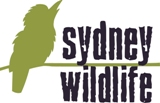
Award-winning environmental education program launches classroom version for teachers
Media release: 28 January 2016
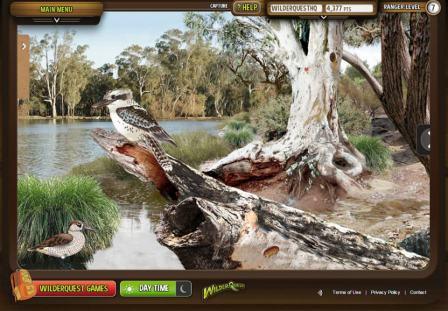
Fun bug hunts, playground prowls, invertebrate investigations and Aboriginal bush lessons are just a few schoolyard activities from a new environmental online learning portal called WilderQuest Learning (WQL) that has been launched today for primary school teachers and their students.
NSW Deputy Chief Executive National Parks and Wildlife Service (NPWS) Michael Wright praised the new free online education portal, developed by NPWS with support from NSW Environmental Trust, which meets the new NSW and Australian Curriculum learning outcomes.
“Australian children are already big fans of WilderQuest’s online games and exciting virtual environments, guided by much-loved characters Ranger Sam, Ranger Pip, Pug and Spot,” Mr Wright said.
“Now with the new WilderQuest Learning Portal for teachers, it means WilderQuest’s unique environmental and science lessons on Australia’s native wildlife and landscapes will be brought-to-life inside classrooms and in playgrounds across NSW and Australia.
“Teachers can sign-up to download the 10 week teacher programs, full of fun and educational classroom activities, digital challenges, citizen science investigations and environmental games which inspire kids to love and care for nature.”
Over 400 teachers from 330 individual schools have already registered for WilderQuest Learning after being invited by NPWS to trial the new portal and provide feedback prior to its launch.
School teacher Carolyn Taylor from Holy Family Merewether School in Newcastle commends WQL’s environmental lesson plans and online resources for educators.
“Children love new digital technologies and they are critical to learning in the 21st century. So it’s great I can use WilderQuest Learning to plan lessons that encourage children to explore and play outside in nature,” said Ms Taylor.
Aboriginal knowledge and culture is also presented by local knowledge holders from around NSW both online and during visits to national parks.
The WilderQuest Learning Portal has been designed for stages 1, 2 & 3 (K-6). The 10 week teacher programs prescribe online classroom activities, outdoor learning and park visits, linked to both NSW and Australian curricula in Science, Geography and History with a focus on Information and Communication Technology (ICT)
Capability and the recently adopted Australian Cross-Curricular Priorities.
Key features the students will see include a NSW map providing live weather information to their personalised ‘Cubby’ and six environments from desert, alpine, woodlands, rainforest, town and coast to explore as well as photographic games and beautifully shot landscape videos.
Over the next three years, further innovative WilderQuest Learning resources will be added to the Learning Portal including new online Aboriginal cultural education resources for the Aboriginal WilderQuest Campfire, due to launch February 2017.
Visit WilderQuest Learning here:www.nationalparks.nsw.gov.au/wilderquest-learning
Reforms to Better Manage Our Coast
Planning Minister Rob Stokes today (13.11.2015) released draft reforms for consultation to make coastal management in NSW simpler, forward-thinking and easier to implement.
“The NSW Government recognises the importance of our state’s saltwater economy and we want to see thriving, resilient communities living, working and playing on a healthy coast now and into the future,” Mr Stokes said.
“We want to replace and improve on the outdated and complex web of laws managing our coast. The current Act is complex, difficult to navigate, and its one-size-fits all approach is no longer fit for purpose.
“Since the original Coastal Protection Act was enacted in 1979 our understanding of coastal processes has improved dramatically. We know our coastline is not a fixed object, but a dynamic, ever-changing environment with a range of natural processes.”
The reforms include:
• A draft Bill for a new Coastal Management Act.
• Key elements of a new Coastal Management Manual.
• Proposals for a new Coastal Management State Environmental Planning Policy (SEPP).
The draft Bill redefines the coast as four distinct areas of coastal wetlands and littoral rainforests; coastal vulnerability areas; coastal environment areas and coastal use areas to identify each area’s unique management requirements.
The manual will provide guidance to local councils and clear, step-by-step instructions to support them to manage their coast using the new Coastal Management Act.
The new SEPP will help manage the legacy of existing coastal hazards and help plan to ensure new hazards are avoided.
A three-month consultation period will run to ensure everyone has a chance to have their say. Go to www.haveyoursay.nsw.gov.au
_____________________________
Our future on the coast: NSW coastal management reforms
The public consultation package includes a draft Coastal Management Bill, an Explanation of Intended Effect for the proposed new Coastal Management State Environmental Planning Policy (SEPP), and key elements of a draft coastal management manual.
Additional elements of the proposed new framework will be released later for public comment, including further components of the manual, maps of the coastal zone that will form part of the SEPP and proposals concerning the effects of coastal erosion on coastal boundaries.
Have your say
The public is invited to read the documents for consultation and provide feedback about the new approach.
Submit feedback by 29 February 2016 via emailcoastal.reforms@environment.nsw.gov.au, online consultation form or post to:
Office of Environment and Heritage, PO Box A290 , Sydney South. NSW 1232
UWS and International research finds aridity will impact carbon storage, plant productivity
29 January 2016
Two landmark studies by Western Sydney University and an international team of scientists have revealed increasing aridity worldwide could significantly impact the diversity of crucial microorganisms and key ecosystem services such as plant productivity and soil carbon sequestration.
Drylands occupy about 41 percent of the earth's surface, and are home to 38 percent of the world's population. Climate models predict the proportion of drylands will further expand by 10% by 2100 due to overgrazing, erosion and climate change. Yet there remains a lack of knowledge about how this will affect existing ecosystem services.
In a world first, an international team of scientists has studied 80 dryland sites in every continent except Antarctica in an attempt to map the future of the diverse, thriving microbial communities living in soils across the world.
The first study, led by Professor Fernando Maestre (Universidad Rey Juan Carlos, Spain) and published in the Proceedings of the National Academy of Sciences journal, found that as soil became more arid, there was a corresponding reduction in the abundance and diversity of bacteria.
In the second study, published in Nature Communications, scientists investigated how microbial diversity loss affected the crucial ecological functions of drylands. They also conducted a national survey in Scotland covering multiple ecosystem types typically found in temperate ecosystems. Using these two independent databases, the international team of researchers found that microbial diversity is vital to maintaining the capability of ecosystems to provide multiple functions and services simultaneously. Even when accounting for impacts such as climate, soil abiotic factors and spatial predictors of ecosystem functions, the positive effects of microbial diversity were maintained.
"The study has a clear message for scientists, policy makers, and organizations involved in management and conservation policies," says the first author of Nature Communication paper Dr Manuel Delgado Baquerizo, from the Hawkesbury Institute for the Environment at Western Sydney University.
"Losses in microbial diversity derived from human activities and climate change will reduce ecosystem functions and services, such as food and fiber production, climate regulation, and nutrient cycling."
Senior author Professor Brajesh Singh, from the Global Centre for Land-Based Innovation at Western Sydney University, says the studies have severe consequences for the global population.
"90% of human settlements in dryland are based in developing countries, posing serious challenges to food security, carbon sequestration and desertification," he says.
"For example, it is estimated that severe degradation in 10-20 % of global drylands could affect about 250 million people, which will impact the Sustainable Development Goals of the UN."
Professor Singh says the studies clearly indicate the need to develop new approaches to protect soil biodiversity to ensure the multifunctionality of terrestrial ecosystems is preserved for future generations.
"To reduce projected loss in key ecosystem services, further expansion and deterioration in terrestrial ecosystems need to be minimised," he says.
"This will require a coordinated approach to slow down the rate of climate change, in combination with changes to land use patterns to reduce overgrazing by local populations."
Have your say on biosecurity management in NSW
NSW Department of Primary Industries Media Release
Landowners, community and industry are encouraged to have their say on how biosecurity risks are managed in NSW, as consultation gets underway surrounding the regulations to support the new Biosecurity Act 2015.
The Department of Primary Industries (DPI) Deputy Director General, Bruce Christie, said the Biosecurity Act 2015 provides an opportunity to review how biosecurity risks are managed in NSW.
“Biosecurity protects our $12 billion primary industries sector, our food supply, our native flora and fauna and our infrastructure and assets from adverse impacts of animal and plant pests, diseases and weeds,” said Mr Christie.
“The Act aims to minimise these threats while simultaneously reducing red tape surrounding its management.
“However, before the Biosecurity Act 2015 commences supporting regulations need to be developed.
“This initial consultation phase will provide an opportunity for us to review how biosecurity risks are managed and work together to develop a simple but solid management system.
“We are calling for feedback on how best to manage these risks so that we can ensure the regulations we develop are flexible and responsive to them, while also meeting business, environmental and community expectations.
“Dedicated materials and discussion papers are now available online and we welcome comment and feedback from landowners, community and industry.”
Topics include aquatic biosecurity, animal biosecurity, plant biosecurity, stock foods, fertilisers and chemical residue, weeds, animal pests, certification and auditing.
“Biosecurity can often be taken for granted, however it’s vital for the health, wellbeing and prosperity of everyone in NSW,” said Mr Christie.
“Biosecurity is a shared responsibility and together we can protect NSW’s strong economy, safe healthy food supply and unique natural environment.”
The closing date for initial feedback on the papers is Friday 12 February 2016, while there will be further ongoing consultation over the next 12 months as the regulations are developed.
For more information visit www.dpi.nsw.gov.au/biosecurityact
NSW Container Deposit Scheme: Have Your Say
On 21 February 2015, the Premier, the Hon. Mike Baird MP, announced the implementation of a container deposit scheme (CDS) by 1 July 2017.
A container deposit scheme (CDS) uses rewards to encourage people to return their drink containers to a collection point. CDSs are a way to reward environmentally responsible behaviour, reduce drink container litter and increase recycling.
The NSW Container Deposit Scheme Discussion Paper is your opportunity to tell us what kind of CDS you would like to see in NSW.
This discussion paper has been prepared by the NSW Environment Protection Authority, on behalf of the Container Deposit Scheme Advisory Committee, appointed by the Minister for the Environment.
Have your say
Submit your feedback on the discussion paper by Friday 26 February 2016.
For more information, visit the EPA website.
Online Consultation
Date: Dec. 18, 2015 - Feb. 26, 2016, Time: 10:30pm — 12:00pm
More Information container.deposit@epa.nsw.gov.au or (02) 9995 5555 Agency Website
Have your say on modifications to the Gingko Mineral Sands Mine extension
18.01.2016: Departmental Media Release - Department of Planning and Environment
A proposal to make modifications to the Gingko Mineral Sands Mine located approximately 40 kilometres west of Pooncarie is on exhibition for community feedback.
The Department of Planning and Environment is keen to hear the community’s views on the proposal which seeks to:
extend the existing development area by approximately 32 hectares
increase the biodiversity offset areas by 1,411 hectares to account for unauthorised clearing.
Biodiversity offsets protect and manage biodiversity in one area in exchange for impacts on biodiversity in another area.
In May 2013, the Department of Planning and Environment issued a formal notice to Cristal Mining after more land was cleared than the approval allowed. The company agreed to substantially increase the existing offset areas for the mine to compensate for the unauthorised clearing.
A spokesperson for the Department said the local community always has an opportunity to share their views.
“Community consultation is an integral part of the planning process and the applicant will have to respond to the feedback we receive.
Submissions are taken into consideration when we assess projects and develop our recommendations,” the spokesperson said.
“It’s easy to participate by going online and we encourage everyone to take a look and have their say.”
To make a submission or view the Environmental Assessment (EA), visit www.majorprojects.planning.nsw.gov.au.
Submissions can be made until Friday, 12 February 2016.
Written submissions can also be made to:
Department of Planning and Environment
Attn: Executive Director – Resource Assessments and Business Systems
GPO Box 39, Sydney NSW 2001
The application and EA is also available to view in person at:
• Department of Planning and Environment, 23-33 Bridge Street, Sydney
• Wentworth Shire Council, 26/24-28 Adelaide Street, Wentworth
• Nature Conservation Council, Level 2, 5 Wilson Street, Newtown
_________________________
Direct link: www.majorprojects.planning.nsw.gov.au/index.
Australian Developed Online insomnia treatment also prevents depression
January 28th, 2016: by Gayle McNaught and Dan Wheelan: UNSW
An online program used to treat insomnia can also significantly reduce anxiety and depression with improvements persisting for at least six months, new research shows.
Black Dog Institute researchers, in partnership with the Australian National University, University of Sydney, and the University of Virginia trialled an online insomnia program to see if it could reduce depression symptoms in adults and prevent escalation into major depression.
Called SHUTi™ or Sleep Healthy Using the Internet, the six week intervention combines traditional sleep hygiene tips – such as an uncluttered bed and minimising alcohol and television – with cognitive behaviour therapy (CBT) to address the psychological underpinnings of the problem.
The program was delivered online to over 500 Australians with a further 500 Australians allocated to another online program containing information about general health.
Results, published today in the prestigious journal Lancet Psychiatry, found the SHUTi treatment group experienced significantly reduced insomnia, anxiety and depression, with these improvements persisting for at least six months.
Insomnia is closely associated with many mental illnesses, both as a symptom and a potential trigger. It co-occurs most commonly in major depression with around 80% of people diagnosed with depression experiencing insomnia. Around 40% of those suffering insomnia may also have undiagnosed yet clinically significant depressive symptoms.
UNSW Scientia Professor of Mental Health and Black Dog Institute Director, Helen Christensen, said there are two important conclusions to take from the results.
“This is the first trial in the world to demonstrate that CBT-based insomnia treatment can also have a significant impact on the development of depression,” Professor Christensen said.
“Since insomnia treatment is rarely stigmatised, this will remove a significant hurdle for those people who feel uncomfortable seeking help. It is also of significant importance for young people, who may not be able to specifically identify depression symptoms but are aware of their insomnia.
“Secondly, the success of the SHUTi program has significant implications for the clinical delivery of mental health interventions.
“This program had the results compared to face to face treatment but was delivered by automated software, giving us a cost-effective way for us to quickly distribute quality treatment and prevention programs across large geographic areas and to a wide range of users.“
Visit the Black Dog Institute website to find out more.
Sign up for a SHUTi subscription here SHUTi $168.87 AUD, Black Dog Institute Discount for Australian customers
Effectiveness of an online insomnia program (SHUTi) for prevention of depressive episodes (the GoodNight Study): a randomised controlled trial. Prof Helen Christensen, PhD†correspondenceemail, Philip J Batterham, PhD†, John A Gosling, BSc†, Lee M Ritterband, PhD, Prof Kathleen M Griffiths, PhD, Frances P Thorndike, PhD, Prof Nick Glozier, PhD, Bridianne O'Dea, PhD, Prof Ian B Hickie, MD, Prof Andrew J Mackinnon, PhD Published Online: 27 January 2016. The Lancet Psychiatry. DOI: doi.org/10.1016/S2215-0366(15)00536-2
Senior Australian of the Year award for emergency medicine pioneer
25 January 2016 - by Amy Coopes: UNSW
New drugs, killer bugs, one-punch deaths and terror threats – if it happens in Sydney, Gordian Fulde sees it first.
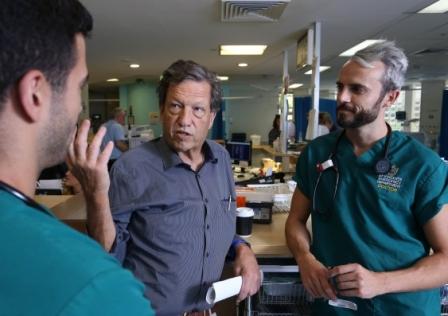
Head of St Vincent Hospital's emergency department, UNSW Associate Professor Gordian Fulde, centre. Photo courtesy St VIncent's Hospital.
After 30 years on the frontlines of one of Australia’s busiest emergency rooms, UNSW Associate Professor Gordian Fulde is something of a household name. The star of hit reality series Kings Cross ER, Fulde is also an outspoken advocate on the social issues that see his waiting room overflow, weekend after weekend: Mental health and homelessness, drugs and alcohol, a casual violence that would have been unthinkable three decades ago.
But behind every sensational headline and political point scored, there is a human face, and Fulde, who on Monday was named Senior Australian of the Year for his ongoing contribution to the community, has seen them all.
“We have the most rich, most powerful people sometimes even in the world, and at the same time the most socially powerless and disenfranchised,” says Fulde, Director of Emergency at St Vincent’s Hospital and a conjoint associate professor at UNSW.
“They can be in one bed to the next and it’s absolutely brilliant. And we treat them all the same.”
Emergency medicine hasn’t always been so glamorous.
If there’s a new recreational drug, chances are we will see it first. If there is a trend in heart attacks, kidney stones, pneumonia, or whatever, we’re the first to sense something’s not right.
Fulde knew from “well before the age of 10” that he wanted to follow his German-born parents into medicine. His father was a cardiothoracic surgeon and his mother a pathologist.
After training at the University of Sydney, Fulde went into general surgery where, as fate would have it, he took a job at Sutherland Hospital requiring him to also oversee the emergency department (ED), known back then as casualty or ‘cas’.
“Traditionally, emergency was the pits,” he says. “In terms of appeal, it was up there with the toilets and roach motels.”
There was no triage system, no career path, nothing. The bells and whistles of modern emergency medicine were little more than science fiction. Yet Fulde found himself falling under the ED’s spell, spending less and less time in the operating theatre until eventually, he decided to put the scalpel down.
“My mother never forgave me, but I knew I’d found what I really wanted to do.”
When the very first emergency medicine exams were held in the UK, Fulde was the third person in the world to sign up – and the first to pass.
He’s long been a “St Vincent's boy” – his father had ties to the hospital and a young Fulde did his internship there. In 1982, he was appointed the hospital’s Director of Emergency.
A pioneer of the field, Fulde went on to found the Australasian College of Emergency Medicine, cementing its place as a standalone specialty.
“I am the only person standing, let alone working, from that era,” says Fulde.
“It was a significant thing, a pretty cool thing to have been a part of. And I’m still here.”
Every morning at 8 o'clock – even on the days he is not rostered on the floor – Fulde leads ward rounds, receiving a handover from overnight staff on the patients who occupy the ED’s 50 or so beds.
This particular Monday there’s the full spectrum: facial fractures from weekend assaults, a pedestrian hit by a car, UTIs and appendicitis, an international rugby player with heart trouble. In one of the padded isolation rooms, someone is coming down from an ice binge.
Someone thinks you have stolen their parking spot and they will scratch your car, or punch your head in. Thirty years ago, that was unthinkable. Now women get assaulted, and no one is surprised.
A middle-aged commuter cyclist is wheeled in on an ambulance gurney clutching what Fulde refers to as the Green Trumpet – a whistle containing the inhalable painkiller penthrox. His collarbone is visibly deformed, and later scans reveal broken ribs and internal injuries.
“It’s not fair is it?” Fulde says to the man as he is whisked past.
“Not at my age” replies the cyclist with a wan smile.
Straddling the outskirts of the CBD and Sydney’s red light district, St Vincents’ ED is the canary in the coalmine, says Fulde. As central Sydney’s trauma centre, it sees more misadventure than many other emergency departments.
Located in Darlinghurst, on the road to Kings Cross, it also has a reputation for “sex drugs and rock ‘n’ roll, perhaps unfairly, given the lion’s share of work is with the sick and elderly.
In the 1980s and '90s, the hospital was on the front lines of Sydney’s AIDS epidemic, and more recently was designated the city’s SARS responder. It is fully equipped for a natural disaster or extremist attack. During the Lindt café siege Fulde’s teams were on standby to receive the first wave of victims.
“If there’s a new recreational drug, chances are we will see it first. If there is a trend in heart attacks, kidney stones, pneumonia, or whatever, we’re the first to sense something’s not right.”
Though use of the stimulant drug ice gets a lot of media and political attention, Fulde says alcohol remains the number one culprit in substance-related emergency presentations.
But a new culture of violence is what troubles Fulde most.
“Someone thinks you have stolen their parking spot and they will scratch your car, or punch your head in,” he says. “Thirty years ago, that was unthinkable – I had nuns walking around. Now women get assaulted, and no one is surprised.”
As soon as Fulde finishes with one patient, another arrives. Emergency medicine moves at frenetic pace, with minutes or even seconds crucial to a successful outcome. Fulde typically does 10 things simultaneously and at speed, often forgetting to eat breakfast or lunch. He says emergency is not for everybody.
“You have to be a people person, and really cope with anything that’s thrown at you,” he says.
Burnout is a real concern, and the stress and shift work can end in divorce, drinking or worse.
Patients who leave home thinking today will be like any other day can, and do, die, leaving Fulde with grieving families who never had a chance to say goodbye.
“There is no real training that will help you ... And that’s the really horrible part,” he says.
Every emergency physician has their triggers and coping mechanisms. As a father of two daughters, Fulde would go home after treating a young female patient and hug his children extra tight.
“Has it made me say live every day to the fullest? No. It comes down to your philosophy of fate, or religion, or superstition,” he says.
“The key is to appreciate what you’ve got – love, your family – that can really sustain you.”
Fulde’s wife of more than 30 years, medical administrator Lesley Forster, is the head of the UNSW Rural Clinical School. He credits her with teaching him how to navigate the pot-holed world of hospital politics, which continues to be a family affair – both their daughters are also UNSW-trained doctors at St Vincents.
Perhaps surprisingly, Fulde says the memories that stay with you aren’t necessarily the most dramatic ones.
The stakes can be high, but so too the rewards. There are few areas of medicine where you can make such a profound difference to nearly everyone you see.
“Those people who die in front of your eyes, who you form a human relationship with, they stay with you. As they should.”
The stakes can be high, but so too the rewards. There are few areas of medicine where you can make such a profound difference to nearly everyone you see, Fulde says.
And it’s not all about life and death. Fulde says he’s constantly amazed by the sexual misadventures that present to the ED.
“We routinely see the most unbelievable stuff, even my most seasoned staff say ‘wow, this is different’,” he says. But he immediately evokes the Vegas clause: what happens in the ED stays in the ED.
Fulde’s mantra is a simple one: Prime Minister or pauper, you are first and foremost a patient. It’s a pragmatism that has won him friends in all quarters.
“You treat everybody the same, as though they were a loved one, and you play everybody down the wicket,” he says.” I’ve got no axe to grind.”
Head OnAwards 2016: Open For Submissions Categories:
Portrait Prize - Landscape Prize - Mobile Prize - Student Prize
Over the years, Head On Photo Festival has awarded over $500,000 worth of photography equipment and cash prizes through the Head On Awards and exhibited 170 finalists overseas.
Vulvar cancer rates surge in Australian women under 60
Over the past thirty years, vulvar cancer rates have increased by 84 per cent in women under 60 years of age, new research shows.
The joint study by Cancer Council NSW, The Royal Hospital for Women and UNSW Australia found that 1,755 women under the age of 60 were diagnosed with vulvar cancer from 1982 – 2009, a 2.5% average increase in rates in this age group every year.
Professor Karen Canfell, Director of Cancer Research at Cancer Council NSW, said the findings could be potentially associated with an increased exposure to the sexually transmitted human papillomavirus (HPV) infection.
“Exposure to HPV types 16 and 18 appears to increase the risk of developing vulvar cancer, and we know that HPV DNA is found in approximately 40% of all vulvar cancers.
“The findings are consistent with an increase in the proportion of HPV-attributable cases of vulvar cancers as a result of changing sexual behaviour in women born from the 1950s onwards, and increased exposure to HPV in this group.
“Vulvar cancer is typically diagnosed in women aged 60 and above, and the highest proportion of cases is among women aged 80 and over. However, we are now seeing that over 30% of cases are being diagnosed in women under 60.
“The first generation HPV vaccines were introduced in Australia in 2007 and are expected to provide women with a level of protection against vulvar cancer as they age,” Professor Canfell said.
Despite the dramatic rise in diagnoses of women under the age of 60, no significant increase in vulvar cancer rates were found in older women, aged 60 and above.
In good news, the study found that over the last 30 years, vulvar cancer mortality rates were stable in women under 60, and decreased by 24 per cent in women over the age of 60.
Ellen Barlow, Clinical Nurse Consultant at Royal Hospital for Women and PhD student with UNSW’s School of Women and Children’s Health, said the decreasing mortality rates of vulvar cancer in older women may reflect earlier diagnosis as a result of women having better access to health information.
“It’s positive to see more women presenting with early stage disease because with the appropriate treatment these women have excellent survival figures.
“It’s very important that women are aware of the signs and symptoms of vulvar cancer. Although these cancers can sometimes be hard to detect, the symptoms include itching, burning or pain, and there is usually a lump or ulcer on the vulva”.
The research has been published in the International Journal of Gynaecological Cancer and can be accessed here.
For more information on the symptoms of vulvar cancer and the human papilloma virus, visit the Cancer Council website or call Cancer Council NSW Information and Support on 13 11 20 to speak to a cancer professional.
Survey finds 'Southern Horizon' the favourite alternative Australian flag design
26 January 2016: University of Western Sydney (UWS)
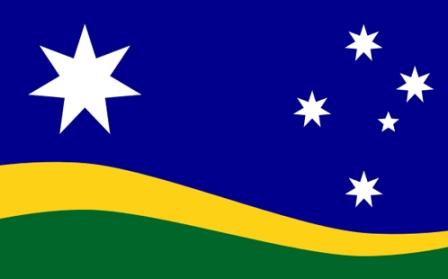
'Southern Horizon' flag design
A public survey into alternative Australian flag designs by Dr Benjamin T. Jones from Western Sydney University has attracted over eight thousand responses, with the 'Southern Horizon' the favourite option.
As part of a larger Australian Research Council funded project looking at Australian national symbols, six popular alternative flag designs were presented to survey participants between 16 December and 25 January.
The 'Southern Horizon' was the most popular choice, with 31 per cent of the vote, with the 'Reconciliation Flag' placing second at 28 per cent.
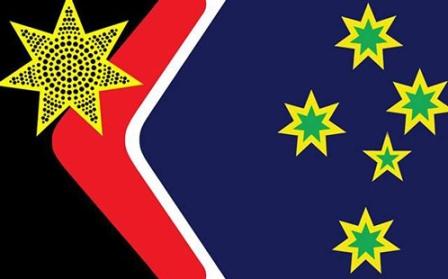
'Reconciliation Flag' design
Dr Jones says the survey result mirrors the recent flag referendum (opens in new window) in New Zealand, where the winning alternative design, the 'Silver Fern', maintained the blue background and red stars of the current national flag.
"Those who support a new Australian flag design fall primarily into two categories; those who want a neutral design with some link to the current flag, and those who want a completely new design with specific recognition of Aboriginal and Torres Strait Islander peoples," he says.
"Similar to New Zealand, the winning design in this survey, the 'Southern Horizon' flag, maintains the blue backdrop of the Australian flag, as well as the Southern Cross and the Federation Star. There are minimal changes beyond the removal of the Union Jack."
Key findings of the survey include:
While 8,140 people took part in the survey, only 6,427 choose a favorite alternative design. This can be interpreted as a protest vote from those who want to keep the current flag, and from those who favour a design not included in the survey.
88 per cent of participants identified as Australian with British, Irish or European heritage. 3 per cent identified as Aboriginal of Torres Strait Islander.
64 per cent of respondents believed the Australian flag should change, compared with 36 per cent who believed it should remain the same.
The Eureka Flag polled well and came in third, with 15 per cent of the vote, however many commentators specifically rejected the Eureka design for its negative association with unions and extreme right-wing groups.
The most common responses when asked what elements should be in a new Australian flag were "simplicity", "Southern Cross", and "Green and Gold"
Most participants who favoured a new flag suggested they would support any design that did not have a Union Jack, even if it was not their favourite.
Dr Jones says the response to the survey has been enthusiastic, and a government-run alternative flag poll would provide a fair and democratic way to fully explore the issue.
"Australia has never had a truly democratic process to choose a national flag. The 1901 competition for a flag of government — not a national flag — required a British element and British approval," he says.
"The winning design, the 'Blue Ensign', became the national flag only in 1954 when the Queen assented to Prime Minister Robert Menzies' Flags Act. The people were not involved."
"The response to this survey shows a proper national conversation on the Australian flag and a democratic vote is long overdue."
Maj. Gen. Orme Awarded Distinguished Service Cross (DSC)
Tuesday, 26 January 2016: The Hon Stuart Robert MP, Minister for Veterans' Affairs, Minister for Human Services, Minister Assisting the Prime Minister for the Centenary of ANZAC
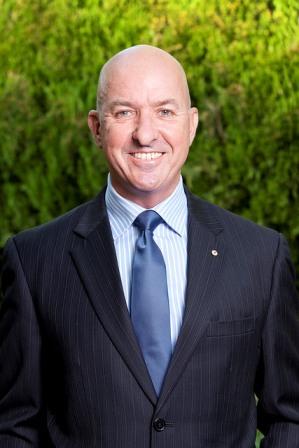
Minister for Veterans’ Affairs Stuart Robert today congratulated Deputy President of the Repatriation Commission Major General Craig Orme AM CSC on being awarded the Distinguished Service Cross (DSC) in this year’s Australia Day Honours.
During his 37-year military career, General Orme’s operational experience included deployments in Malaysia, Iran, Kuwait and US Central Command, as well as in the Middle East and Afghanistan.
The DSC acknowledges his distinguished command and leadership in warlike operations as Commander Joint Task Force 633 on Operations SLIPPER and OKRA from September 2013 to December 2014.
Upon leaving the Australian Defence Force (ADF) a year ago, General Orme joined the Repatriation Commission, which is part of the Department of Veterans’ Affairs (DVA) portfolio.
“General Orme’s highly impressive career is characterised by his service,” Mr Robert said.
"As an Army officer, he defended the nation. Now—equipped with an understanding and firsthand experience of the issues faced by contemporary veterans—he looks after the interests of others who have served, and their families.”
Mr Robert said General Orme was well placed to play a key role in DVA’s efforts to continuously improve the way the organisation conducts business and interacts with members of the veteran community.
“General Orme is committed to ensuring DVA continues to help veterans and their families lead productive, satisfying lives after they leave the ADF,” Mr Robert said.
"In the past 12 months, General Orme has been heavily involved in work to introduce online claims forms, develop a single dispute resolution pathway for claims, update IT systems and reduce claims processing times.”
The Minister said that approximately six per cent of DVA staff are Reservists or former members of the ADF, so they have personal experience of the needs of clients.
Some of the support and services available through DVA include compensation, rehabilitation, employment assistance programs, innovative online mental health resources, and treatment for a range of conditions.
Top: Maj Gen Craig Orme AM, CSC, Deputy President Repatriation Commission. Image courtesy Department of Veterans' Affairs (Australia)
Immunology of the rheumatoid joint
Published on 28 Jan 2016
Rheumatoid arthritis is an inflammatory disease that mainly affects the joints in which the body's immune system attacks its own tissues. This animation produced by Nature Reviews Immunology and Nature Reviews Rheumatology guides us through the immune pathways involved in the disease, from the first signs of self-reactive immune cells to joint damage and other symptoms, and highlights opportunities for new treatments.
Nature Reviews Immunology (http://www.nature.com/nri) and Nature Reviews Rheumatology (http://www.nature.com/nrrheum) have full responsibility for all editorial content. This content is editorially independent of sponsors.
Finger tracing can lift Sydney students performance in maths
28 January 2016
Tracing eases burden on students' working memories
Sydney schoolkids who used finger tracing fared better with previously unseen geometry and algebra questions, new research has found.
The use of multiple senses can improve student learning in maths, University of Sydney studies suggest. Image: iStock
Students who trace certain maths problems with a finger are able to solve them more quickly and easily, University of Sydney research shows.
Studies involving 275 Sydney school children aged between nine and 13 found that tracing over elements of maths problems enhanced how they understood and solved problems in geometry and algebra.
Tests revealed students who used their finger to trace over practice examples while simultaneously reading geometry or arithmetic material were able to complete tasks more quickly and correctly than those who did not use the same technique.
“Our findings have a range of implications for teachers and students alike. They show maths learning by young students may be enhanced substantially with the simple addition of instructions to finger-trace elements of maths problems,” said Dr Paul Ginns, Senior Lecturer in Educational Psychology and the research’s corresponding author.
“We are cautiously confident such effects could be applied in the classroom and to subjects outside of maths, but more research is clearly required,” he said.
This simple, zero-cost teaching approach can enhance the effectiveness of mathematics instruction across multiple areas of the subject.
Dr Ginns, and co-researchers Professor Janette Bobis, Dr Fang-Tzu Hu and Erin Byrne, believe using an index finger to physically touch and trace the angles of a triangle, for example, can result in that information receiving processing priority in the brain. Doing so may reduce the load on working memory and its ability to retain complex material by ‘chunking’ information together.
“At the classroom level, teachers can assist students to learn new mathematical content by giving instructions to ‘trace over’ the important elements of worked examples that already appear in mathematics textbooks or worksheets. This simple, zero-cost teaching approach can enhance the effectiveness of mathematics instruction across multiple areas of the subject,” said Dr Ginns.
The research is published in Learning and Instruction and Applied Cognitive Psychology.
Teachers have used finger-tracing since the early 1900s, when Montessori got young children to trace over letters of the alphabet made from sandpaper with their index fingers. While this approach was at the time based on intuition rather than evidence, later studies would confirm that finger tracing aids recognition of letters and shapes.
Yet, researchers are only now starting to explore if finger tracing’s benefits could extend to more complex mathematical tasks that require higher levels of abstract thinking and problem solving.
150 lives saved each year in NSW hospitals thanks to sepsis awareness program
25 January 2016 - by Dan Wheelan: UNSW
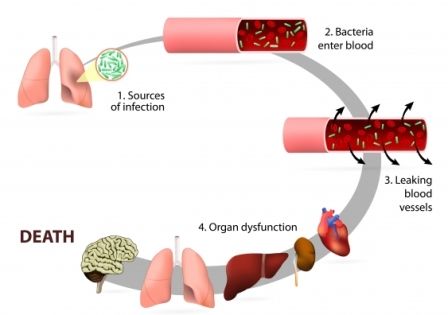
Patients presenting with sepsis in NSW hospitals are receiving life-saving treatment earlier thanks to a program that has transformed the way emergency departments respond to the condition, a UNSW study shows.
Sepsis – an inflammatory response to an infection which can led to septic shock and organ dysfunction – is one of the most common reasons for a patient's health to deteriorate in hospital, and was involved in 17.5% of all in-hospital deaths in NSW in 2009.
The SEPSIS KILLS program was introduced into emergency departments in 2011, after the NSW Clinical Excellence Commission founds significant delays in the recognition and management of sepsis in NSW hospitals.
The program educates staff to recognise risk factors, signs and symptoms of sepsis, resuscitate patients with rapid intravenous fluids and antibiotics and then refer them to senior clinicians and teams.
This program saves lives and should be rolled out across Australia.
Researchers from UNSW Australia and the Clinical Excellence Commission (CEC) collected data from 13, 567 patients from 2011–2013, to assess the success of the program.
The results of the study are published today in the Medical Journal of Australia.
They found the proportion of sepsis patients receiving intravenous antibiotics within 60 minutes of triage increased from 29.3% to 52.2% over the period.
The research found the number of sepsis patients being treated immediately or within 10 minutes of arrival increased. At the same time, there was a decrease in mortality from 19.3% in 2009–2011 to 14.1% in 2013, and there were also significant declines in time spent on the intensive care ward and total length of stay in hospital.
Chief clinical epidemiologist and senior author of the study, UNSW Professor Mary-Louise McLaws, praised the collaboration of the state’s emergency department clinicians involved in the program.
“Some 70% of sepsis comes through our emergency departments. The commitment of emergency department staff to the program saved an additional 150 lives each year through their adherence to the SEPSIS KILLS program,” Professor McLaws said.
“I am pleased that patients with sepsis are now being treated with the same urgency as those with stroke, heart attack and trauma.This program saves lives and should be rolled out across Australia.”
Since the conclusion of the study, NSW public hospitals have begun extending the SEPSIS KILLS program to inpatient areas and wards.
Top: Sepsis is one of the leading causes of death in hospital patients worldwide. It causes more deaths than prostate cancer, breast cancer and HIV/AIDS combined (Photo: iStock).
2020 target set for more threatened Australian species
Media release - 22 January 2016: The Hon. Greg Hunt MP. Minister for the Environment
Sixteen more threatened bird and mammal species will start on the road to recovery after the Australian Government today committed to improving their trajectories by 2020.
The mahogany glider, eastern quoll, western ringtail possum, woylie, black-footed rock-wallaby, Gilbert’s potoroo, northern hopping-mouse and Christmas Island flying-fox will join the list of 20 mammal species prioritised for action under Australia’s first Threatened Species Strategy.
The cassowary, swift parrot, eastern curlew, Australasian bittern, malleefowl, south-eastern redtailed black cockatoo, white-throated grasswren and golden-shouldered parrot are also in line for special attention, as the latest additions to the list of 20 priority bird species.
I’m delighted to be joined by Threatened Species Commissioner Gregory Andrews to make this exciting announcement today at Werribee Zoo south-west of Melbourne.
The landmark Threatened Species Strategy released last year identified the first tranche of birds and mammals to be targeted for action. Today’s announcement of the remaining priority species marks another milestone for wildlife conservation in this country.
For too long, the problem of species decline has been put in the ‘too hard’ basket. We’ve taken a new and different approach, and I’m heartened to see it is already proving its worth.
Threatened Species Commissioner Gregory Andrews has just provided me with his latest report on the rollout of the strategy, and the news is good. The number of projects benefitting threatened species has just passed the 500 mark.
Hundreds of threatened animals, plants and ecosystems have shared in more than $130 million in Australian Government funding since 2014, through the National Landcare Programme, Green Army, 20 Million Trees and other programmes.
This investment continues to grow as more and more volunteers, community and conservation groups, scientists, state and territory governments, farmers and businesses join us to protect the bush and its wildlife.
Today, I want to add to those partnerships by announcing two new initiatives for our threatened species.
The first initiative commits $200,000 to a BirdLife Australia project to better understand our country’s spectacular waterbirds, such as the Australasian bittern, black swan, brolga, freckled duck, little egret and pied heron.
This project, supported by the Australian Government’s National Environmental Science Programme (NESP), builds on previous work to quantify the state of Australia’s terrestrial birds and extends it to waterbirds for the first time.
Understanding their population trends can tell us a lot about the health of sensitive freshwater and coastal habitats. It also can provide ‘early-warning’ signals of species in decline, and help inform Australia’s bilateral migratory bird agreements.
The second initiative commits the Australian Government to developing a new four-point action plan to protect the Christmas Island frigatebird, a species listed as the ninth most evolutionary distinct and globally endangered bird in the world.
The frigatebird breeds on Christmas Island and ranges across south-east Asia and the Indian Ocean. It will benefit from scientific research to understand its ecology through the NESP, an urgent review of its conservation status and recovery plan within Australia, an investigation into what marine conservation options we have available, and finally, once these actions are underway, commencement of a discussion with Indonesian Government officials about what our two nations can do together to secure this remarkable seabird’s future.
Threatened Species Commissioner Gregory Andrews and Director of National Parks Sally Barnes are working on the action plan.
Find out more about the priority mammal and bird species:
Read the Threatened Species Commissioner’s latest progressreport: 2015
Find out more about the National Environmental Science Programme: www.environment.gov.au/nes
Review of Medicare Benefits Schedule
Media Release: The Hon Sussan Ley MP; Minister for Health,Minister for Aged Care, Minister for Sport
The Government is committed to working with health professionals and patients to build a Medicare Benefits Schedule that is based on contemporary clinical practice.
This is evidenced by our clinician-led Taskforce reviewing all 5700 items on the MBS, many of which have not been updated or assessed in decades, or at all.
Recent public consultation undertaken as part of the MBS Taskforce’s work demonstrates the important support amongst health professionals for this clinical process, with over 93 per cent surveyed agreeing parts of the MBS were out-of-date and required review.
This intensive work is being undertaking in stages over a 2 year period, with the MBS Taskforce’s first round of advice now available for public consultation until 8 February 2015 here
This first stage of work has provided recommendations about the immediate removal of lower-volume MBS items in some specific specialities where there is clinical consensus that they are ‘obsolete’ and no longer represent clinical best-practice. These are also items that clinical experts deem will not have adverse impacts on a patient’s access to health services if removed.
Reasons range from more-clinically appropriate and/or efficient technologies and procedures already listed on the MBS through to patient safety, unnecessary doubling-up of item claims and decreasing usage.
For example, in diagnostic imaging, invasive tests to diagnose blood clots in the lower leg or gall bladder problems have now been replaced by non-invasive ultrasound technology.
There are 23 MBS items in total recommended for removal in this first stage of work from a handful of specialities, including:
• Diagnostic imaging – 7 items
• Ear, nose, and throat surgery – 9 items
• Gastroenterology – 5 items
• Obstetrics – 1 item
• Thoracic medicine – 1 item
These 23 MBS items were used a combined total of 52,500 times in 2014-15, worth $6.8 million in Medicare benefits paid.
As part of our commitment to consultation throughout this process, the Taskforce will now seek further views on the 23 MBS items they have recommended for removal before final decisions are made.
It is important to understand that this is not by any means a comprehensive or complete list of final findings about the final makeup of the MBS.
Never has such a comprehensive review of all 5700 items on the MBS been undertaken since Medicare’s inception in the 1980s and many more items will require more in-depth, complex evaluation.
It is also important to remember further advice from the Taskforce will not just focus on the removal of items from the MBS altogether, but also maintaining clinically-relevant MBS items, the addition of new MBS items where appropriate, and more intricate changes around the rules governing the eligibility and use of an MBS item for a particular patient cohort.
The work of the MBS Review is part of the Turnbull Government’s commitment to an integrated approach to health policy development and complements our concurrent review of primary health care and policy work to improve private health insurance for consumers, as well as our bold plans to transform mental health service delivery.
My number one priority for this MBS review has always been, and remains, building a healthier Medicare for Australian patients, health professionals and taxpayers and I am determined to deliver it.
New theory linking brain activity to brain shape could throw light on human consciousness
January 27, 2016
UNSW Australia scientists have shown that complex human brain activity is governed by the same simple universal rule of nature that can explain other phenomena such as the beautiful sound of a finely crafted violin or the spots on a leopard.
The UNSW team has identified a link between the distinctive patterns of brain function that occur at rest and the physical structure of people's brains.
"It has been a mystery why these spontaneous patterns of brain activity occur when people are simply lying in a brain scanner not thinking about anything in particular and not doing any explicit task," says senior author UNSW psychologist Associate Professor Joel Pearson.
"Our study provides the first over-reaching theory which can explain this. Using the maths of a ubiquitous natural phenomenon -- harmonic waves -- we have shown how resting brain function is related to the shape of people's brains.
"The approach we developed also provides a new technique for analysing the enormous amount of data being generated on brain activity.
"And it could lead to a new way to diagnose disorders of consciousness by helping us understand the very complex patterns of brain activity associated with being aware and sentient."
The study, by Dr Selen Atasoy and Associate Professor Pearson of the UNSW School of Psychology and Isaac Donnelly of the UNSW School of Mathematics and Statistics, is published in the journalNature Communications.
The researchers used data from two imaging techniques -- magnetic resonance imaging (MRI) and diffusion tensor imaging (DTI) -- to build three-dimensional maps of the structure of the brains of ten people.
"The MRI gave us the structure of their cortex -- the wrinkly surface of the brain -- and the DTI gave us an anatomical map of the underlying connections of the white matter in the brain," says Associate Professor Pearson.
The team then analysed these brain maps using the mathematical framework of Laplace Eingenmodes, or harmonic waves, which describe natural vibrations of a system where all parts move together at the same frequency.
"Our results show the shape of the brain matters, in the same way that the precise wooden shape of a Stradivarius violin matters if you want to produce an exquisite sound when the strings are vibrated," says Associate Professor Pearson.
"Brain activity resonates within the precise anatomical structures of the brain to produce the resting networks of oscillations we observe."
Says lead author UNSW's Dr Selen Atasoy: "The patterns we predict with the harmonic waves on the human brain can be compared to the musical notes composing a complex musical piece; the building blocks of more complex patterns of brain activity."
Says Associate Professor Pearson: "Interestingly, the same kinds of harmonic waves are thought to explain other self-organising phenomena in nature, such as the patterns that sand forms when sitting on a vibrating metal plate, or the development of biological patterns such as the stripes on tigers and spots on leopards."
Selen Atasoy, Isaac Donnelly, Joel Pearson. Human brain networks function in connectome-specific harmonic waves.Nature Communications, 2016; 7: 10340 DOI:10.1038/ncomms10340
Trove now on Facebook
Thursday January 28th, 2016

Hello world, Trove is expanding its social media horizons with a foray into Facebook. If you’ve not heard of us before, Trove is the National Library of Australia’s discovery service which brings together the Library's digital content with records from collecting institutions around Australia. We’ve got pictures, music, manuscripts, archived websites, journals, newspapers, books, biographies and a whole lot more, all brought together into one online service.
We look forward to sharing stories and Trove news with you, as well as hearing about your experiences with Trove. If you ever have any questions about Trove, just click on the ‘Ask Trove!’ button on our Facebook page and fill in our enquiry form.
Facebook page: www.facebook.com/TroveAustralia
Trove helps you find and use resources relating to Australia. It's more than a search engine. Trove brings together content from libraries, museums, archives and other research organisations and gives you tools to explore and build.
Trove is many things: a community, a set of services, an aggregation of metadata, and a growing repository of full text digital resources.
Trove is the result of collaboration between the National Library, Australia's State and Territory libraries and hundreds of cultural institutions around Australia, working together to create a legacy of Australia’s knowledge for now and into the future.
Best of all, Trove is yours. As you edit, comment, tag or contribute content you are helping to build a better service for everyone.
Website: trove.nla.gov.au
MGSM’s MBA ranked number one in Australia, 56 in the world by Financial Time
25 January 2016: Macquarie University
The Macquarie Graduate School of Management (MGSM) has once again been ranked Australia’s top business school according to the Financial Times (FT). The School has also improved its global ranking, moving up 12 places to #56 worldwide.
MGSM is one of only three Australian business schools to make the prestigious top 100 along with the UNSW’s Australian Graduate School of Management (AGSM) and Melbourne Business School (MBS). All three schools improved their positions in the rankings this year with AGSM moving up 9 places to #66 and MBS moving up 3 places to #87.
Professor Alex Frino, Dean MGSM, said: “Australian schools should be proud of their performance as a whole. Education continues to be an important export for Australia and results like this improve the country’s reputation overall.
“Over the past year, MGSM has experienced the effects of this boost firsthand. Since entering the rankings, we’ve had 50% plus growth in international enrolments. Perhaps more importantly, is the quality of international students that have flooded MGSM with applications.”
According to Professor Alex Frino, MGSM’s outstanding result reflects the School’s ongoing commitment to providing students with the very best opportunities, which sets them up to achieve at the highest levels in their post-MBA career.
MGSM also climbed the rankings for research performance and the international mobility of its graduates.
“In these areas we have made significant effort by increasing our number of global partnerships with leading institutions and hiring the best financial, business, management and leadership minds to produce world-first research,” said Professor Frino.
“These improvements have paid off. This year, MGSM improved 10 places in research performance, and we were the only school to improve our international mobility ranking – we are now ranked 40th globally, up 14 places,” he said.
In 2015, Professor Frino introduced a MGSM Board of Advice consisting of Chitra Ramkrishna, CEO of the National Stock Exchange Group India; Maureen Jensen, Chief Administrative Officer of the Ontario Securities Commission; Kim McKay, AO, CEO of the Australian Museum; Sir James Mirrlees, Nobel Laureate and Professor at the Chinese University Hong Kong; Professor Yu Yongda of Tsinghua University; and the Hon Andrew Rogers QC, Former Supreme Court Judge.
“I have assembled this group of highly experienced and respected professionals to discuss big picture issues, including the school’s vision and goals, the opportunities I am considering, our plans to get there and any obstacles we may face. They will be playing a key role in mentoring the school’s future progress,” said Professor Frino.
“With such talented professionals at the helm and a truly great ranking, I think I have every reason to be proud of our School and look forward to the year ahead.”
Cats domesticated in China earlier than 3000 BC
January 25, 2016
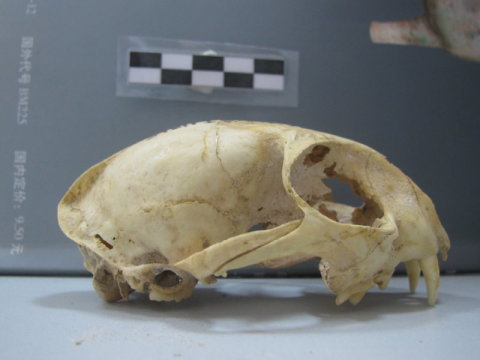
Side view of a domestic cat skull from the Neolithic site of Wuzhuangguoliang (Shaanxi, 3200-2800 BC). Credit: © J.-D. Vigne, CNRS/MNHN
Were domestic cats brought to China over 5,000 years ago? Or were small cats domesticated in China at that time? There was no way of deciding between these two hypotheses until a team from the 'Archéozoologie, Archéobotanique: Sociétés, Pratiques et Environnements' laboratory (CNRS/MNHN), in collaboration with colleagues from the UK and China, succeeded in determining the species corresponding to cat remains found in agricultural settlements in China, dating from around 3500 BC. All the bones belong to the leopard cat, a distant relation of the western wildcat, from which all modern domestic cats are descended. The scientists have thus provided evidence that cats began to be domesticated in China earlier than 3,000 BC. This scenario is comparable to that which took place in the Near East and Egypt, where a relationship between humans and cats developed following the birth of agriculture.
Their findings are published on 22 January 2016 in the journal PLOS ONE.
The cat is the most common domestic animal in the world today, with over 500 million individuals. All of today's domestic cats descend from the African and Near Eastern form of the wildcat (Felis silvestris lybica). According to work published in 2004, humans and cats first started to form a close relationship in the Near East from 9000 to 7000 BC, following the birth of agriculture.
In 2001, researchers from the Chinese Academy of Sciences in Beijing discovered cat bones in agricultural settlements in northern China (Shaanxi province) dating from around 3500 BC. Was this evidence of a relationship between small Chinese cats and humans in the fourth millennium BC in China? Or was it the result of the arrival in China of the first domestic cats from the Near East? There was no way of deciding between these two hypotheses without identifying the species to which the bones belonged. Although there are no less than four different forms of small cat in China, the subspecies from which modern cats are descended (Felis silvestris lybica) has never been recorded there.
To try to settle the question, a collaboration of scientists principally from CNRS, the French Natural History Museum (MNHN), the University of Aberdeen, the Chinese Academy of Social Science and the Shaanxi Provincial Institute of Archaeology undertook a geometric morphometric analysis, which, in the absence of ancient DNA, is the only way of differentiating the bones of such small cats, which have very similar morphologies whose differences are often imperceptible using conventional techniques. The scientists analyzed the mandibles of five cats from Shaanxi and Henan dating from 3500 to 2900 BC. Their work clearly determined that the bones all belonged to the leopard cat (Prionailurus bengalensis). Still very widespread in Eastern Asia today, this wildcat, which is a distant relation of the western wildcat (Felis silvestris lybica), is well-known for its propensity to frequent areas with a strong human presence. Just as in the Near East and Egypt, leopard cats were probably attracted into Chinese settlements by the proliferation of rodents who took advantage of grain stores.
These conclusions show that a process comparable to the one that took place in the Near East and in Egypt developed independently in China following the birth of agriculture in the eighth millennium BC. In China it was the leopard cat (P. bengalensis) and not the western wildcat (F. silvestris) that started to form a relationship with humans. Cat domestication was, at least in three regions of the world, therefore closely connected to the beginnings of agriculture.
Nevertheless, domestic cats in China today are not descended from the leopard cat but rather from its relation F. silvestris lybica. The latter therefore replaced the leopard cat in Chinese settlements after the end of the Neolithic. Did it arrive in China with the opening of the Silk Road, when the Roman and Han empires began to establish tenuous links between East and West? This is the next question that needs to be answered.
Jean-Denis Vigne, Allowen Evin, Thomas Cucchi, Lingling Dai, Chong Yu, Songmei Hu, Nicolas Soulages, Weilin Wang, Zhouyong Sun, Jiangtao Gao, Keith Dobney, Jing Yuan. Earliest “Domestic” Cats in China Identified as Leopard Cat (Prionailurus bengalensis). PLOS ONE, 2016; 11 (1): e0147295 DOI:10.1371/journal.pone.0147295
Scientists preserve the endangered ghost orchid
January 26, 2016
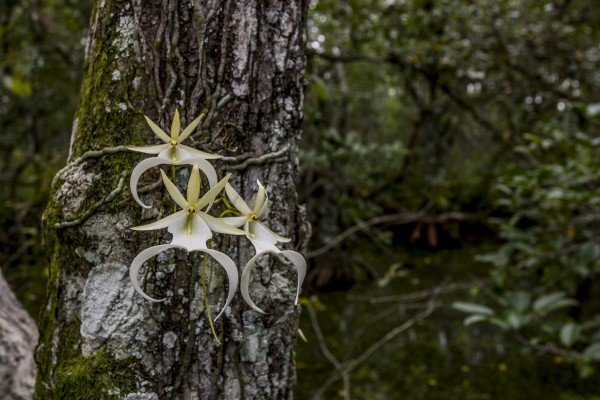
The rare and often-poached Ghost Orchid is seen on a tree in Southwest Florida. UF/IFAS scientists are preserving this endangered consumer favorite. Credit: Courtesy, UF/IFAS
University of Florida Institute of Food and Agricultural Sciences researchers believe they're on the verge of helping conserve the popular but endangered Ghost Orchid, a plant that's often poached.
"We've successfully developed procedures to culture plants from seeds in the lab and then successfully acclimatize them into our greenhouse," said Michael Kane, professor of environmental horticulture at UF/IFAS. "We've also obtained a high survival and vigorous re-growth rate when they're planted back into the wild."
This rare orchid is unique for several reasons. First, it resembles a ghost when its white flower moves at night; hence, it is known as the Ghost Orchid. It is also leafless, and its roots attach to the bark of the host tree.
About 2,000 ghost orchids remain in Florida, all the more reason to step up efforts to stabilize the current populations, Kane said. The Ghost Orchid also grows in the Bahamas and Cuba. However, researchers are learning that these populations are thriving in very different environmental conditions than those in South Florida.
UF/IFAS scientists are trying to give ghost orchids the best chance to survive after they're planted back in the native environment. Until now, there's only been non-scientific information on ways to grow the Ghost Orchid, Kane said. There's no information on how to reliably produce them in a lab or reintroduce them into nature.
Kane and doctoral student Hoang Nguyen are trying to change that trend. For three years, Kane and Nguyen, with funding from the U.S. Fish and Wildlife Service, have worked to bring Ghost Orchid seeds back from Southwest Florida to a propagation lab at the UF campus in Gainesville to see if they can germinate the seed under sterile conditions on a gelled medium and then transfer the plants into a greenhouse.
Their latest results showed they could develop a successful seed culture technique for the Ghost Orchid so they can replant it in the wild. Orchid seeds in the wild won't germinate unless they are infected with a mycorrhizal fungus, Kane said. The UF/IFAS researchers worked with Larry Zettler, biology professor and director of the Orchid Recovery Program at Illinois College, to stimulate seed germination in the lab.
The scientists' work has been so successful that Nguyen won the outstanding research poster contest at last June's meeting of the Society for In Vitro Biology. Their study is currently being considered for publication.
Recently, they brought some of the plants back to their native habitat in the Florida Panther National Wildlife Refuge in eastern Collier County, Florida, and about 70 out of 80 of these Ghost Orchids have survived and are vigorously growing, Nguyen said. They are seeing similar results with Ghost Orchids planted later at the Naples Botanical Garden.
"For orchid conservation, this is big," Kane said. "We are very excited."
Ghost orchids became more famous through a popular book, "Orchid Thief," about a man arrested for stealing them from trees in a forest in Collier County, near the Everglades. The book was made into a 2002 movie, titled "Adaptation," with Meryl Streep.
The above is reprinted from materials provided by University of Florida Institute of Food and Agricultural Sciences. The original item was written by Brad Buck.
________________________________________________________________________________________________________
Disclaimer: These articles are not intended to provide medical advice, diagnosis or treatment. Views expressed here do not necessarily reflect those of Pittwater Online News or its staff.